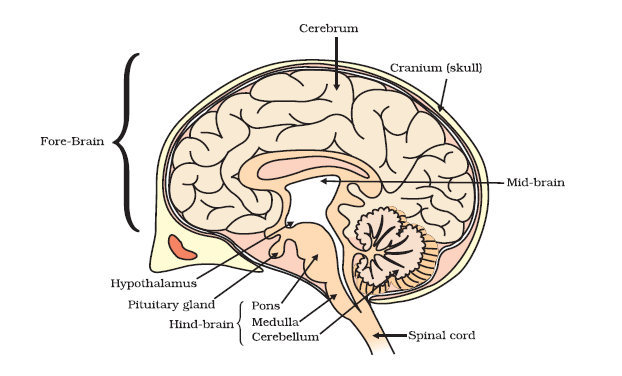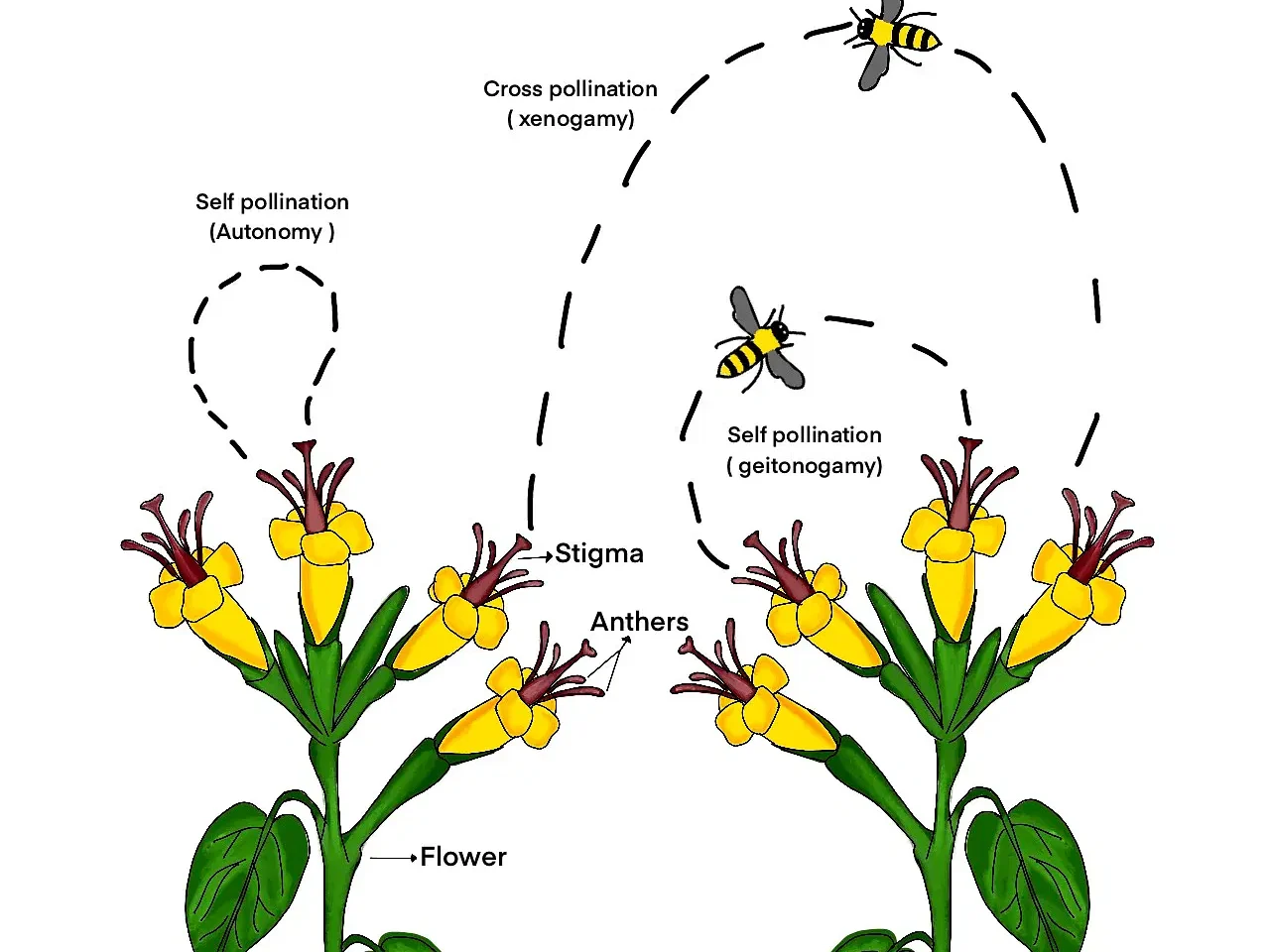Human Brain
The human brain is a highly complex organ that serves as the control center for the entire body. It is responsible for regulating bodily functions, processing sensory information, and enabling cognitive functions such as thinking, memory, and emotion. Weighing about 1.4 kilograms, the brain is composed of roughly 86 billion neurons, each forming synapses with thousands of other neurons, creating a vast network of communication pathways.
Major Parts of the Human Brain
- Cerebrum
- Cerebellum
- Brainstem
- Diencephalon
 >
>1. Cerebrum
The cerebrum is the largest part of the brain, making up about 85% of the brain’s weight. It is responsible for voluntary activities, intelligence, memory, and emotions.
- Structure: The cerebrum is divided into two hemispheres (left and right), connected by a bundle of fibers called the corpus callosum. Each hemisphere is further divided into four lobes:
- Frontal Lobe: Involved in reasoning, planning, movement, emotions, and problem-solving.
- Parietal Lobe: Processes sensory information such as touch, temperature, and pain.
- Temporal Lobe: Responsible for processing auditory information and is crucial for memory and speech.
- Occipital Lobe: Dedicated to processing visual information.
- Functions:
- Frontal Lobe: Controls executive functions, motor skills, language, and emotional expression.
- Parietal Lobe: Integrates sensory information and is involved in spatial orientation and navigation.
- Temporal Lobe: Handles auditory processing, memory formation, and language comprehension.
- Occipital Lobe: Interprets visual stimuli and information.
- Cerebral Cortex: The outer layer of the cerebrum, composed of gray matter. It is responsible for higher brain functions such as sensation, voluntary muscle movement, thought, reasoning, and memory. It is highly folded, increasing the surface area to accommodate more neurons.
- Subcortical Structures:
- Basal Ganglia: Involved in the control of voluntary motor movements, procedural learning, and cognitive, emotional functions. Important for habit formation.
- Limbic System: Includes structures like the hippocampus (essential for memory formation), amygdala (involved in emotion regulation), and hypothalamus (regulates autonomic and endocrine functions, such as hunger, thirst, and body temperature).
2. Cerebellum
The cerebellum, located under the cerebrum, coordinates voluntary movements and helps maintain posture and balance. It has a highly folded surface to increase the area for neurons.
- Structure: The cerebellum consists of two hemispheres connected by the vermis. Its surface is covered by tightly packed, parallel grooves called folia.
- Functions:
- Motor Control: Ensures smooth, coordinated movements.
- Balance and Posture: Maintains balance and proper posture.
- Motor Learning: Involved in the learning and fine-tuning of motor skills.
- Cognitive Functions: Recent studies suggest the cerebellum also plays a role in cognitive processes like attention and language.
3. Brainstem
The brainstem connects the brain to the spinal cord and controls basic life functions such as breathing, heartbeat, and blood pressure. It includes three main parts: the midbrain, pons, and medulla oblongata.
- Midbrain (Mesencephalon):
- Structure: Located between the pons and the diencephalon.
- Functions: Processes visual and auditory information and controls eye movements. Contains the substantia nigra, which is involved in movement and reward.
- Pons:
- Structure: Located between the midbrain and the medulla oblongata.
- Functions: Relays messages between the cerebrum and the cerebellum and helps regulate breathing. Contains nuclei that deal with sleep, respiration, swallowing, bladder control, hearing, equilibrium, taste, eye movement, facial expressions, and posture.
- Medulla Oblongata:
- Structure: The lower part of the brainstem, connecting to the spinal cord.
- Functions: Controls vital functions like heart rate, blood pressure, and breathing. Also involved in reflex actions such as vomiting, coughing, sneezing, and swallowing.
4. Diencephalon
The diencephalon is located beneath the cerebrum and includes structures such as the thalamus, hypothalamus, epithalamus, and subthalamus.
- Thalamus:
- Structure: A large, dual-lobed mass of gray matter situated in the center of the brain.
- Functions: Acts as a relay station for sensory information, directing it to the appropriate areas of the brain for processing. Also involved in regulating consciousness, sleep, and alertness.
- Hypothalamus:
- Structure: A small, but crucial part of the diencephalon located below the thalamus.
- Functions: Regulates vital bodily functions, including temperature, hunger, thirst, and circadian rhythms. It controls the autonomic nervous system and the endocrine system via the pituitary gland. Also plays a role in emotional responses and behaviors.
- Epithalamus:
- Structure: Located at the dorsal part of the diencephalon.
- Functions: Contains the pineal gland, which secretes melatonin and regulates sleep-wake cycles. Involved in the regulation of motor pathways and emotions.
- Subthalamus:
- Structure: Located ventrally to the thalamus.
- Functions: Involved in controlling motor functions and is connected to the basal ganglia and motor cortex.
Functional Areas of the Brain
- Motor Areas:
- Primary Motor Cortex: Located in the frontal lobe, responsible for voluntary movement.
- Premotor Cortex: Involved in planning movements.
- Supplementary Motor Area: Coordinates movement sequences.
- Sensory Areas:
- Primary Somatosensory Cortex: Located in the parietal lobe, processes sensory information such as touch, temperature, and pain.
- Primary Visual Cortex: Located in the occipital lobe, processes visual information.
- Primary Auditory Cortex: Located in the temporal lobe, processes auditory information.
- Association Areas:
- Integrate and interpret sensory and motor information.
- Involved in higher cognitive functions such as learning, remembering, thinking, and speaking.
Brain Structure and Functions
- Basal Ganglia: A group of nuclei involved in coordinating voluntary movements and establishing motor habits. Includes the caudate nucleus, putamen, globus pallidus, substantia nigra, and subthalamic nucleus.
- Limbic System: A complex system of nerves and networks in the brain, involving several areas near the edge of the cortex concerned with instinct and mood. It controls basic emotions (fear, pleasure, anger) and drives (hunger, sex, dominance, care of offspring).
Brain Protection
The brain is well-protected by the skull, meninges, and cerebrospinal fluid (CSF).
- Skull: A bony structure that encases the brain.
- Meninges: Three protective membranes (dura mater, arachnoid mater, and pia mater) that surround the brain and spinal cord.
- Cerebrospinal Fluid (CSF): A clear fluid that cushions the brain, removes waste products, and provides a stable chemical environment.
Neuroplasticity
Neuroplasticity refers to the brain’s ability to reorganize itself by forming new neural connections throughout life. This allows the brain to adapt to new experiences, learn new information, and recover from injuries.
- Synaptic Plasticity: Changes in the strength of synaptic connections between neurons.
- Structural Plasticity: Changes in the brain’s physical structure in response to learning, experience, or injury.
Common Brain Disorders
- Alzheimer’s Disease: A progressive neurodegenerative disease that causes memory loss, confusion, and changes in behavior. It is characterized by the buildup of amyloid plaques and neurofibrillary tangles in the brain.
- Parkinson’s Disease: A disorder of the central nervous system that affects movement, often including tremors. It is caused by the degeneration of dopamine-producing neurons in the substantia nigra.
- Stroke: Occurs when the blood supply to part of the brain is interrupted or reduced, preventing brain tissue from getting oxygen and nutrients. Can result in the death of brain cells and loss of function in affected areas.
- Epilepsy: A neurological disorder marked by recurrent, unprovoked seizures. It is caused by abnormal electrical activity in the brain.
- Multiple Sclerosis (MS): An autoimmune disease that damages the myelin sheath, the protective covering of nerves, resulting in disrupted communication between the brain and the body.
Conclusion
The human brain is a complex and powerful organ responsible for controlling all aspects of bodily functions and behavior. Its intricate structure and numerous specialized areas enable it to process vast amounts of information, coordinate physical movements, and facilitate advanced cognitive processes. Understanding the brain’s anatomy and functions is crucial for appreciating how we interact with and respond to the world around us.

